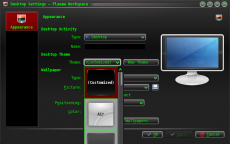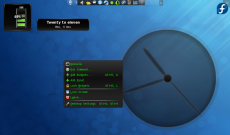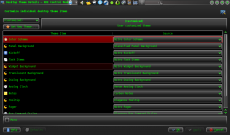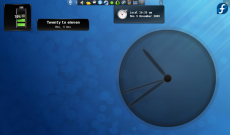도구상자
소개 스크린샷 및 설명 추가하기
가능할 때마다 우리는 이것으로 애플리케이션의 최상위 페이지를 시작합니다 그것을 달성하기 위한 코드는
{|class="tablecenter vertical-centered"
|[[Image:YourScreenshot.png|250px|thumb]]
|설명 텍스트
|}
텍스트 형식 지정
머리글 사용하기
Each heading goes on its own line starting and ending with two or more '=' characters. Once there are more than a handful of headings on a page they automatically create a Table of Contents, so use them. The number of '=' characters determines their level in the Table of Contents, thus your headings should be '==Main section name==', '===Subsection name===', '====Sub-subheading name here====', and so on. Avoid using single '=', as that denotes a page heading and every wiki page already has one made from its name; for example, this page's title "Toolbox/ko" appears as its page heading.
bold 및 italic 사용하기
Blip은 굵고 기울임꼴인 단어를 지정하는 데 사용됩니다.
'''bold text'''을 사용하여 굵은 텍스트를 지정하고 ''italic text''을 사용하여 기울임꼴 텍스트를 지정합니다.
In order to ensure we get easy and accurate translations, please adhere to the typographical guidelines.
코드 스니펫 추가하기
We have templates to assist in correctly displaying code snippets. Examples of use in various situations are available on the typographical guideline page
If you have problems displaying pipe characters in your code snippet, please see the explanation and markup detailed on Typographical Guidelines
들여쓰기 추가하기
- ":" is used for an indent, and was used in multiples in some old pages. This is deprecated, and causes some problems, so the multiples will be removed as they are found. A single ":" indents by four characters.
날짜 형식 지정하기
Dates in a purely numerical format cause confusion, due to differences in expectations of geographical zones. Please format dates as
18 Mar 2011
with the month either spelled out completely or in abbreviated form, and the year in 4-digit format. The day may be single or double-digit.
글머리 기호 목록
*는 글머리 기호입니다. **는 두 번째 단계를 줍니다:
* 아몬드
* 견과류
** 캐슈넛
* 건포도
농산물
- 아몬드
- 견과류
- 캐슈넛
- 건포도
열거형
열거형은 '#'을 사용하여, 동일한 방식으로 생성됩니다.
# 체로 치기
# 섞기
## 충분히 휘젓기
# 빵 굽기
생산물
- 체로 치기
- 섞기
- 충분히 휘젓기
- 빵 굽기
자세한 내용은 목록의 wikimedia를 참조하십시오.
글머리 기호 목록 및 열거형 결합하기
열거된 하위목록을 글머리 기호 목록에 포함시킬 수 있으며, 그 반대의 경우도 다음과 같습니다:
* 견과류
*# 캐슈넛
*# 병맛
* 다른 것들
생산물
- 견과류
- 캐슈넛
- 병맛
- 다른 것들
동안
* 견과류
*# 캐슈넛
*# 병맛
* 다른 것들
생산물
- 견과류
- 캐슈넛
- 병맛
- 다른 것들
To get each bullet and each sub bullet in its own translation unit you can enter something like this:
* First bullet </translate >
<translate >
** First sub bullet </translate >
<translate >
** Another sub bullet<br /><br />This one consists of two paragraphs </translate >
<translate >
* The next main bullet </translate >
<translate >
** And so on
다음과 같이 표시됩니다:
- 첫 번째 불릿
- 첫 번째 불릿
- 또 다른 서브 불릿
이것은 두 단락으로 구성되어 있습니다
- 다음 기본 불릿
- 기타 등등
다른 종류의 목록에도 동일한 방법이 적용되어야 합니다.
If on the other hand you need to have more sections in the same item, you can do something like this to have each section in a translation unit of its own:
* First bullet </translate >
<translate >
* Second bullet, first section. </translate><br /><br /> <translate > Second section of the
second bullet. This section has a translation unit of its own </translate >
<translate >
* And so on
다음과 같이 표시됩니다:
- 첫 번째 불릿
- 두 번째 불릿, 첫 번째 섹션.
두 번째 불릿의 두 번째 섹션입니다. 이 섹션에는 자체 번역 단위가 있습니다. - 기타 등등
항목화
항목화는 ;과 :을 번갈아 사용하여 생성됩니다. 관련 개체 그룹에 대한 간단한 설명을 제공하는 데 가장 적합합니다.
;동물
: 그들은 돌아다니며 다른 생물들을 잡아먹습니다.
;식물
: 그들은 뿌리를 가지고 있고 지하수와 태양을 먹고 삽니다.
농작물
- 동물
- 그들은 돌아다니며 다른 생물들을 잡아먹습니다.
- 식물
- 그들은 뿌리를 가지고 있고 지하수와 태양을 먹고 삽니다.
링크 추가하기
There are three kinds of links to learn, internal ones, to another userbase page, internal links to a section of a userbase page, and external URL links.
For an internal link the format [[PageLayout]], where you want to display the name of the page, does work, but it is not ideal, particularly for translation to docbook and for localisation. It is better to use the form [[Special:myLanguage/PageLayout|Page Layout]], because that allows translators to link correctly even though the page name is localised. The result is that it directs to the correctly translated page, if one exists. You often need to include the link in a sentence, so in that case you would use
[[Special:myLanguage/PageLayout|this page]]
which displays
Internal links to subsections of a page use character '#' (hash) and should look like this
[[Special:myLanguage/Tasks_and_Tools#Working_with_Languages|...]]
With this kind of link it is very important, that the page you link to declares the reference anchor. If the anchor contains space characters, replace them by character '_' (underscore) when calling the reference. If the reference is found, the section will be automatically displayed by your browser (if it manages anchors). If it is not the case, you will have to go down through the page to find the referenced section. External links are given as the URL and a text separated by a space and delimited by single square brackets as in
[https://en.wikipedia.org/wiki/KDE KDE's Wikipedia page]
which gives KDE's Wikipedia page.
Anchor declaration
Anchor declaration must be done immediatly BEFORE the referenced section, and followed by a blank line separating the anchor and its headline. In the following example just copy in the ID value, the title of associated section. It should look like this:
</translate><span id="Working with Languages"></span> <translate>
If the page containing the section that you link to is not yet marked up for translation, you should omit the </translate > and <translate > tags.
External links are slightly different so
[http://techbase.kde.org/Schedules our road map]
displays
our road map, which would take you straight to the techbase page.
One last thing to note - when you preview your page, all links are live. This gives you two benefits. You can check (by hovering) that your links are set up as you expected, and you can use a red link to create a new page.
애플리케이션 목록 만들기
If you want to make a list of applications like the ones in the subpages of Applications, you should use the AppItem template. Simply enter
{|
{{AppItem|System Settings/Locale|Preferences-desktop-locale.png|
Settings for localized handling of numbers, dates, etc}}A short text.
A few more short lines about the app. This is optional.
|-
{{AppItem|System Settings/Shortcuts and Gestures|Preferences-desktop-keyboard.png|
Shortcuts and Gestures}}Another short text. If you do not type <keycap>Enter</keycap> between the texts
you get one section no matter how long the text is.
|}
그러면 다음과 같은 화면이 표시됩니다:
Settings for localized handling of numbers, dates, etc | |
| A short text.
A few more short lines about the app. This is optional. | |
Shortcuts and Gestures | |
| Another short text. If you do not type Enter between the texts you get one section no matter how long the text is. | |
Note, that you should not prepend "Special:myLanguage" to the page name - the template takes care of that. Also note, that you must give a title, even if the title is the same as the page name.
각주
Footnotes are rarely used in our pages, but if you need them you can place a <ref>text</ref> in the source where the footnote mark should appear. There has to be one <references /> somewhere in the source as well, usually towards the end of the page. This is where the text added by the <ref> tags will appear. For more info see the Wikipedia help page.
텍스트 삽화넣기
중앙에 하나의 이미지 추가하기
[[File:KMail-kde4.png|250px|center]]
Note that you can change the position of the image, but the default is left. The size of the image depends on the circumstances, but for screenshots I recommend no less than 250px and no more than 500px.
Also note that Image: and File: are synonyms.
So that [[Image:KMail-kde4.png]] is the same as [[File:KMail-kde4.png]]. However Image: is deprecated, so prefer File: in new content.
자세한 내용은 mediawiki를 참조하십시오.
클릭 가능한 이미지 만들기 및 캡션 추가하기
Where you need to show more detail, create a moderately sized image, clickable, so that the full-size can be seen. Simply add the parameter '|thumb' within the image parentheses.
A caption can also be added as a parameter, but will only show if '|thumb' is present.
예:
[[File:file_name.png|thumb|this will be the caption]]
썸네일없이 캡션 추가하기
프레임 구문으로 표시된 이미지에도 캡션이 표시됩니다.
예:
[[File:image.png|frame|left|this will be the caption]]
이미지가 텍스트로 흐르지 않도록 방지하기
Sometimes you might not want the text to flow down the sides of your image. You can prevent this by adding a <br clear=all> tag between the file tag and the text in question.
Example:
[[File:image.png]]
<br clear=all>
This text would normally flow down the sides of the image but now it will be found under the image
테이블을 사용하여 여러 이미지를 정확하게 배치하기
{|class="tablecenter" style="border: 1px solid grey;"
|[[Image:Desktop-config-customized.png|230px|center]]||[[Image:Desktop-settings-rightclick.png|230px|center]]
|-
|[[Image:Desktop-theme-details-dialog.png|230px|center]]||[[Image:Plasma-multiple-themes.png|230px|center]]
|}
displays
 |
 |
 |
 |
Note that all the parameters for one image are contained within [[...]], and cells are separated by '||'. To start a new line, insert '|-' on an otherwise-empty line, then '|' at the start of the next one.
For more details on Table formating see mediawiki
Embed a Video
As of July 2012 the MediaWiki EmbedVideo extension has been installed on userbase.kde. This means you can embed videos from various video hosting sites into the page content and have them display in line.
EmbedVideo parser function expects to be called in any of the following ways:
{{#ev:service|id}}
{{#ev:service|id|width}}
{{#ev:service|id|width|align}}
{{#ev:service|id|width|align|desc}}
{{#evp:service|id|desc}}
{{#evp:service|id|desc|align}}
{{#evp:service|id|desc|align|width}}
Where:
service is the name of a video sharing service (See "service name" in the list below) id is the id of the video to include width (optional) is the width in pixels of the viewing area (height will be determined automatically) align (optional) is an alignment (float) attribute. May be "left" or "right". desc (optional) is a short description to display beneath the video when it is aligned
For example, to include the famous "evolution of dance" YouTube video, you'd enter:
{{#ev:youtube|dMH0bHeiRNg}}
And if you wanted scaled down to thumbnail size, on the right with a short description, you could use:
{{#ev:youtube|dMH0bHeiRNg|100|right|This is an embedded video!}}
As of version 1.0, EmbedVideo supports embedding video content from the following services:
| Site | Service Name |
|---|---|
| Dailymotion | dailymotion |
| Div Share | divshare |
| Edutopia | edutopia |
| FunnyOrDie | funnyordie |
| Google Video | googlevideo |
| Interia | interia or interiavideo |
| Revver | revver |
| sevenload | sevenload |
| TeacherTube | teachertube |
| YouTube | youtube and youtubehd |
| Vimeo | vimeo |
메모 및 경고 추가하기
Where a note or warning is relevant within your text, use these templates:
{{Info|This is general information}} displays
{{Note|Some important information at this point}} displays
{{Tip|A helpful piece of advice, something to remember}}displays
{{Warning|Take care - this is a dangerous thing to do}} displays
Where the strongest possible warning is needed, the Remember box can be used, but please use sparingly.
{{Remember|1=This is for things that definitely must not be forgotten}}
You can also change the heading:
페이지 리디렉션
다음을 사용하여 페이지를 자동으로 다른 페이지로 리디렉션할 수 있습니다:
#REDIRECT [[Pagename]]
KDE3 및 KDESC 4 버전의 애플리케이션
By default, KDE SC 4 is assumed. If the KDE SC 4 version is not yet ready for release, or where only a KDE 3 version exists, it may be necessary to document the KDE3 version. In this case you should add the template {{KDE3}}
which displays
![]() Should you be writing about a KDE3 version and KDE SC 4 version on the same page, use icons for both — {{KDE4}} which displays
Should you be writing about a KDE3 version and KDE SC 4 version on the same page, use icons for both — {{KDE4}} which displays
![]()
기타 유용한 템플릿
GUI 아이콘 삽입하기
The best way to refer to icons in the GUI is to display it in the text. This can be done with a template like this: {{Icon|list-add}}. This will display the ![]() icon.
icon.
For this to work, the icon image must have been uploaded to the wiki. See Update an Image for an explanation on how to upload images. The .png files can usually be found here: usr/share/icons/oxygen. If possible use the 16x16 icon. The file name should have an Icon- prefix as in Icon-list-add.png — apart from the prefix the filename should exactly match the usual name. Note, that when using the template you should neither write the Icon- prefix nor the .png file type extension.
The ![]() icon can also be written as
icon can also be written as {{Plus}}, and the ![]() icon as
icon as {{Minus}}. You can also use {{Configure}} to get the ![]() icon, and
icon, and {{Exit}} gets you the ![]() icon.
icon.
커뮤니티 애플리케이션
The final consideration concerns those applications which are not distributed as core KDE applications. These need to be indicated by an icon, placing {{Community-app}}
at the end of your sentence or line, just as you would to denote a footnote in general writing. You then need to add {{Community-app-footnote}} which will create a footnote, like this:
![]() Support for this application can be found from the project's home page
Support for this application can be found from the project's home page
기존 페이지에 주요 편집 만들기
If a page is likely to be open for editing for some time there is a danger of conflicts - someone else may edit at the same time, and saving your edit will cancel out theirs, or vice versa. The way to avoid that is to make a temporary entry, directly under the language bar, using {{Being_Edited}} which will display
완료되면 제거하는 것을 잊지 마십시오!
새 복합 페이지 추가하기
If you need to be able to work on a page for quite some time, over several days, for instance, you may like to use the Construction template - {{Construction}}, which displays
인근 페이지 링크하기
You can add links to a preceding or a following page using the following templates as described here:
{{Prevnext2|prevpage=Previous Pagename|nextpage=Following Pagename|prevtext=The page before this page|nexttext=This page you should read later|index=Index page|indextext=Back to Menu}}
All six arguments are optional. For first pages with no preceeding page or last pages with no following page use this:
{{Prevnext2|nextpage=Following Pagename|nexttext=This page you should read later}}
- Toolbox/ko
- This page you should read later →
{{Prevnext2|prevpage=Previous Pagename|prevtext=The page before this page}}
- ← The page before this page
- Toolbox/ko
If you don't specify an indexname the name of the current page will be displayed.
버그 링크하기
다음 템플릿을 사용하여 Bugzilla의 버그에 직접 연결할 수 있습니다.
{{Bug|123456}}
Please do not forget to add the <s> and </s> to strike through a bug that is closed.
하위 페이지 목록 추가하기
== Subpages of {{FULLPAGENAME}} ==
{{Special:PrefixIndex/{{FULLPAGENAME}}/}}
is very useful when you want to list subpages with active links, such as
Subpages of Toolbox/ko
It does, however, also list all "other-language" pages, so use with discretion.







